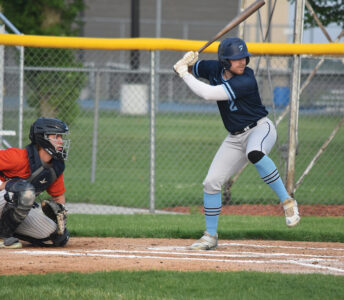MN DNR stocks local lakes with fish

ABOVE: MN DNR Assistant Area Supervisor Nate Hodgins checks out some muskie before they stock the Fairmont lake chains.
FAIRMONT – Wednesday was a bountiful day for the Fairmont Chain of Lakes, as muskies and walleye fry were brought in to re-stock the lake.
The process is done every two years in lakes across the state. Walleye fry are the recent hatchlings of walleye eggs, which they stock at high densities. Minnesota Department of Natural Resources (DNR) Area Supervisor Ryan Doorenbos said the muskies Fairmont receives come from a hatchery in Waterville.
“We get the call, they drain their ponds, we go up there and get the appropriate number that we’re shooting for stocking, which is 314 among all five lakes,” he said. “We spread them out evenly.”
A pickup truck then holds one and tows another container full of fish. Each tank holds around 125 gallons of water, and oxygen tanks are hooked up to provide oxygen and reduce stress on the fish. The whole process takes around a day.
Rather than season being the dominant factor, Doorenbos said hatchery production is the major reason they stock lakes at this time.
“They hatch the [muskie] in May and they feed them all summer long till they get to an appropriate size,” he said. “We’re shooting for about 12 inches in size before we stock them. We’d like to see them even bigger because they have higher survival. That’s driven by the production of the summer.”
Perch, crappie and bluegill reproduce naturally in the lakes, so Doorenbos said they don’t usually stock them. He said muskies do not reproduce in the lakes, making stocking necessary.
“Walleye fry can, but typically not at the rate people tend to angle for them,” Doorenbos said.
There are two main reasons muskie and walleye fry are stocked in Fairmont lakes. First is for anglers, as walleye is a staple of Minnesotan cuisine and muskie creates a unique angling opportunity due to the low density the DNR uses. The second is for ecological purposes.
“[Muskie] can maintain a high-level predator in the system. They have this length limit. They have to be so big to harvest. You maintain a higher level predator in the system for a longer period.”
Each fish also has a minuscule tracker the size of a grain of rice, which can be used to track fish data.
“We know the length of that fish when we stocked it,” Doorenbos said. “When we survey out here and we catch it 5-10 years from now, we’ll know its growth rate because we know what size we put it in at.”





